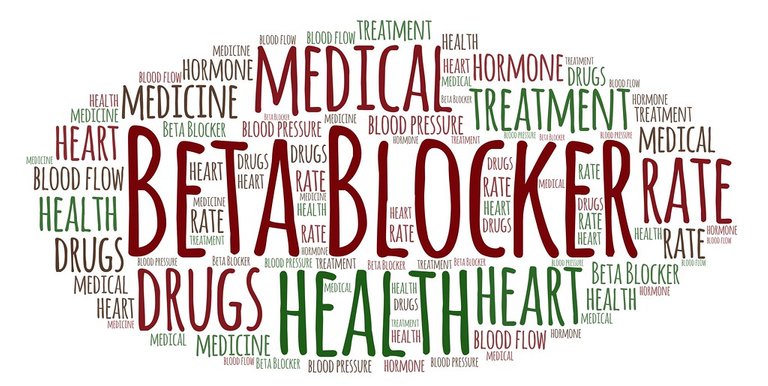Explaining Beta Blockers (Mechanism of Action, Clinical indications, and Adverse Effect)
Either in college or at the university, you must have heard of the word Beta Blockers, so you might be conversant with this word, but if you aren't familiar with it, then follow me to the end of this post, and you would have learnt one or two new things to your knowledge library, understanding what beta blockers are, and their mechanism of actions.
Beta Blockers are a class of drugs that block adrenaline or noradrenaline's effect on the sympathetic nervous system. In general cases, they are used to treat cardiovascular diseases, such as hypertension, tachycardia, myocardial infarction and other cardiovascular diseases. In my previous post, I gave a little explanation of the sympathetic nervous system while explaining the Autonomic Nervous system. The nervous system has the sensory and motor component which the autonomic nervous system falls into. The autonomic nervous system is where the parasympathetic and the sympathetic nervous system fall into place. The parasympathetic part of the autonomic nervous system deals with the resting and digesting state of the body, while the sympathetic part of the nervous system deals with the flight or fight stage of the body, also known as the Emergency, Excitement, and Exercise nervous systems. This is explained in terms that when there is excitement or rush, the sympathetic process is triggered by the neurotransmitter catecholamines which release noradrenaline that allows several parts of the body to work faster, some constrict some dilate and so on. The heart pumps faster, pumping blood faster, the kidney releases renin, and blood vessels dilate and constrict, depending on the areas blood is to move more to, the liver would help with glycogen as glucose to produce energy (ATP). Noradrenaline in the organs responds through receptors known as adrenal receptors (alpha or Beta). The receptors can be alpha receptors or beta receptors. In this post, I will be dealing with Beta receptors.
The heart has the Beta-1 receptor, and when noradrenaline binds with the Beta-1 receptor, the heart rate increases, and the heart pumps more. The Kidney also pocesses the Beta-1 receptor where it releases renin when it binds with noradrenaline, which helps to regulate blood volume and blood pressure. The blood vessel has a Beta Receptor known as the Beta-2 receptor, same with th e pupil (Beta-2 receptor) causing the dilation of the pupil causing the dilation of the pupil, the Lungs (Beta-2 receptors) causing Bronchio dillation as more air goes into the lungs,and the liver (Beta-2 receptor) breaking down glycogen to glucose for ATP. With Beta Blockers, we are preventing the binding of Beta receptors thereby preventing the actions they would exhibit.
Beta blockers can be classified based on the selective regions. This can be classified into Non-selective,and Selective. The non-selective Beta Blocker do not do well distinguishing the different types of Beta receptors either Beta-1 or Beta-2, so they block both Beta receptors. Drugs in this generation of beta blockers include but not limited to propranolol which reduces the heart rate, thereby reducing the cadiac output and decreasing blood pressure, it helps to get the heart to pump efficiently rather than too fast thereby preventing heart failure. The use of Propranolol to decrease heart rate, also reduces oxygen demands, which allows for the improvement of angina. It can reach the brain, causing the dillation of blood vessels that could help in reducing migranes. Timolol is another non-selective beta blocker, it is important in treating Glaucoma, and Ocular hypertension. It blocks the Beta-2 receptors in the eye, thereby reducing the pressure in the eye. It can also be used to treat hemangiomas, myocardial infarction andocular hypertension. Non-selective Beta Blockers, can also have certain adverse effects such as bronchoconstriction of the lungs, Blood Sugar being low as a result of blocking the release of glucose causing low blood sugar level, causing a more difficult situation for diabetic patients.
Selective Beta Blockers are the second generation of Beta Blockers. Selrctive Beta Blockers are selective to Beta-1 receptors. They are less likely to cause adverse effects like that of propranolol and they do the same thing with the propranolol except for the side effect. Drugs such as Atenolol, Metaprolol, Bisoprolol, Esmolol, acebutolol, and betaxolol, can prevent hypertension, heart failure and so on. There is another type of non-selective beta blockers that affects both Beta-1 and Alpha-1. It is important that you know that alpha-1 receptors are common on blood vessels, constricting them when they are activated by noradrenaline, increasing peripheral vascular resistance, and blood pressure. The third generation of beta blockers blocks both Alpha-1 ansd Beta-1 receptors. Carvidolol when taken, dilates the blood vessels, since its blocks the Alpha-1 receptors, and also blocks the beta-1 receptors in the heart, and kidney, causing a drop in heart rate and blood pressure.
Like I said, there can be adverse effects of using Beta blockers. These adverse effects includes bronchoconstriction of the lungs, low blood sugar, Bredycardia (slowing down the heart excessively causing heart blocks), Decompensating heart failure, and fatigue as blood isn't flowing into the muscles
- National Library of Medicine - Beta Blockers
- LiverTox: Clinical and Research Information on Drug-Induced Liver Injury [Internet]- Beta Adrenergic Blocking Agents
- Timeofcare.com - Selective vs non-selective beta blockers
- www.rxlist.com - How Do Nonselective Betablockers Work?
- Cleveland - Alpha-blockers
- .nhs.uk - Beta blockers

Thanks for your contribution to the STEMsocial community. Feel free to join us on discord to get to know the rest of us!
Please consider delegating to the @stemsocial account (85% of the curation rewards are returned).
Thanks for including @stemsocial as a beneficiary, which gives you stronger support.
Quite so interesting to read about Selective Beta Blockers for the first time